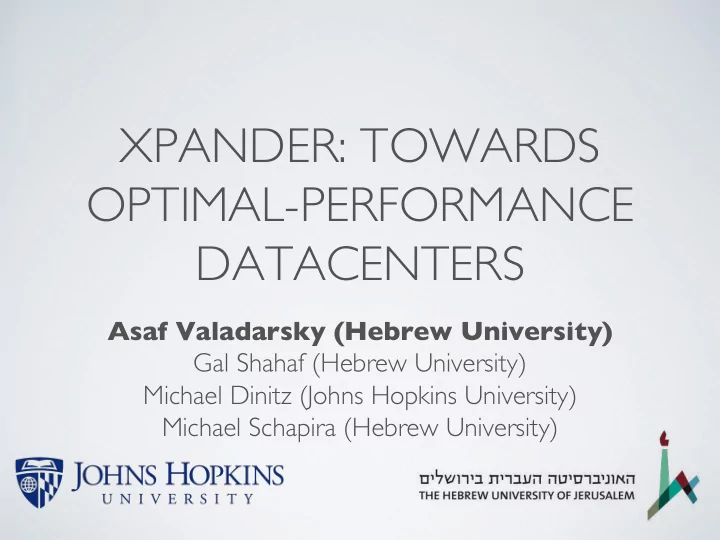

XPANDER: TOWARDS OPTIMAL-PERFORMANCE DATACENTERS Asaf Valadarsky (Hebrew University) Gal Shahaf (Hebrew University) Michael Dinitz (Johns Hopkins University) Michael Schapira (Hebrew University)
DESIGNING A DATACENTER ARCHITECTURE Network Topology? Routing? Congestion Control?
DESIGNING A DATACENTER ARCHITECTURE Performance Deployability ➡ Throughput ➡ Cabling complexity ➡ Resiliency to failures ➡ Operations cost ➡ Path diversity ➡ Equipment costs ➡ … ➡ …
WHAT IS THE “RIGHT” DATACENTER ARCHITECTURE? ???? Jellyfish PERFORMANCE Slim-Fly SWDC, DCell, BCube, c-Through, Helios, … Fat Tree DEPLOYABILITY
AGENDA Reaching that upper-right corner entails • designing “expander datacenters” Xpander : a tangible and near-optimal • datacenter design
EXPANDER DATACENTERS • An expander datacenter architecture: Utilizes an expander graph as its network ➡ topology (see next slide) Employs (multi-path) routing and congestion ➡ control to exploit path diversity
EXPANDER GRAPHS: INTUITION • A graph is called an “expander graph” if it has “good” edge expansion S V\S • Intuition: In an expander graph, the capacity traversing each cut is “large” Traffic is never bottlenecked at small set of links ➡ High path diversity ➡
CONSTRUCTING EXPANDERS • Constructing expanders is a prominent research area in mathematics and computer science • Applications in networking, computational complexity, coding, and beyond
EXPANDER DATACENTERS ACHIEVE NEAR-OPTIMAL PERFORMANCE Support higher traffic loads ➡ More resilient to failures ➡ Support more servers with less network ➡ devices Multiple short-paths between hosts ➡ Incrementally expandable ➡
OUR EVALUATION ➡ Theoretical analyses ➡ Flow- and packet-level simulations ➡ Experiments on network emulator ➡ Experiments on an SDN-capable network
EXPANDER DATACENTERS ARE THE STATE-OF-THE-ART ???? Random Graph Jellyfish PERFORMANCE Low-Diameter Graph Slim-Fly SWDC, DCell, BCube, c-Through, Helios, … Fat Tree DEPLOYABILITY
CAN WE HAVE IT ALL? A well structured Near optimal design performance YES! :)
XPANDER DATACENTER ARCHITECTURE Near-Optimal Deployable Performance ➡ Throughput ➡ Cabling complexity Deployment- ➡ Resiliency to failures ➡ Operations cost Expander Oriented Datacenter ➡ Path diversity ➡ Equipment costs Construction ➡ … ➡ …
XPANDER DATACENTER ARCHITECTURE No links within the Same same meta- number of node links between every two ToR ToR meta- ToR ToR ToR ToR ToR ToR nodes ToR ToR ToR ToR Meta Node ToR ToR ToR ToR Meta Node Same number Leverages a deterministic graph-theoretic of ToRs within any meta-node construction of expanders [BL ’06]
WHERE ARE MY PODS? An Xpander can be divided into smaller “Xpander pods” ToR ToR ToR ToR
XPANDER DATACENTER ARCHITECTURE Topology ToR ToR ToR ToR Multipath Routing Routing (K-Shortest Paths) Congestion Multipath Congestion Control (Multipath-TCP) Control
EXPANDER DATACENTERS ACHIEVE NEAR-OPTIMAL PERFORMANCE Support higher traffic loads ➡ More resilient to failures ➡ Support more servers with less ➡ network devices Multiple short-paths between hosts ➡ Incrementally expandable ➡
NEAR OPTIMAL ALL-TO-ALL THROUGHPUT * All-to-All Throughput Normelized Throughput 1 * 18-port 0.95 0.9 switches Xpander 0.85 0.8 Jellyfish 0.75 0.7 LPS_54 0.65 LPS_62 0.6 0.55 0.5 0 500 1000 1500 2000 Number Of Servers Theorem: In the all-to-all setting, the throughout of any d-regular expander G on n vertices is within a factor of O(logd) of that of the throughput-optimal d-regular graph on n vertices
RESILIENCE TO FAILURES Theorem: In any d-regular expander, any two vertices are connected by exactly d edge-disjoint paths.
NEAR-OPTIMAL THROUGHPUT UNDER SKEWED TRAFFIC MATRICES • Expander datacenters empirically attain near- optimal throughput under skewed TMs (mice and elephants) • We prove that expander datacenters are optimal with respect to adversarial traffic conditions
COST EFFICIENCY: XPANDER VS. FAT-TREE Switch #Switches All-to-All Throughput Degree 8* 80% 121% 10 100% 157% 24 80% 111% *Validated using Mininet experiments
SEE PAPER FOR Analysis of shortest-paths and diameter • Physical layout and costs • Incremental expansion of expander datacenters • Results for skewed traffic matrices • Results for Xpander vs. Jellyfish • Results for Xpander vs. Slim-Fly • Additional results for Xpander vs. Fat Tree • Experiments with the Mininet network emulator • Experiments on the OCEAN SDN-capable network testbed • … •
DEPLOYING XPANDER No links Same within the number of same meta- links node between ToR every two ToR ToR meta- ToR nodes Place ToRs of each meta-node in close proximity ➡ Bundle cables between two meta-nodes ➡ Use color-coding to distinguish between different ➡ meta-nodes and bundles of cables
DEPLOYING XPANDER Analysed physical layout, cabling complexity, • #cables and cable length for both large-scale and “container” datacenters Switch #Switches #Servers #Cables Cable Length Throughput Ports 4.2 km vs 42 vs. 48 504 vs. 512 420 vs. 512 32 5.12km 109% (87.5%) (98.44%) (82%) (82%) 10.5 km vs 66 vs. 72 1056 vs. 1152 1056 vs. 1152 48 11.5km 142% (92%) (92%) (92%) (92%)
CONCLUSION We show that expander datacenters outperform traditional • datacenters Sheds light on past results about random and low- ✓ diameter graphs based datacenters We present Xpander , a novel datacenter architecture • Suggests a tangible alternative to today’s datacenter ✓ architectures Achieves near-optimal performance ✓
QUESTIONS? THANK YOU! See project webpage at: https://husant.github.io/Xpander/
Recommend
More recommend